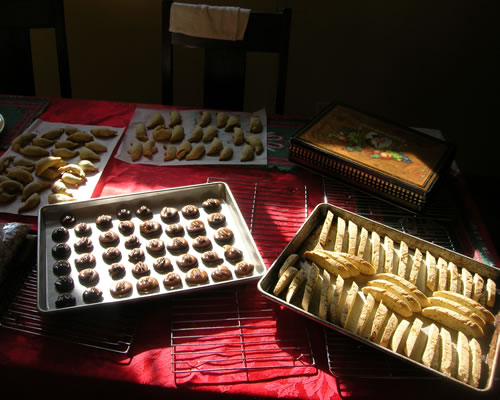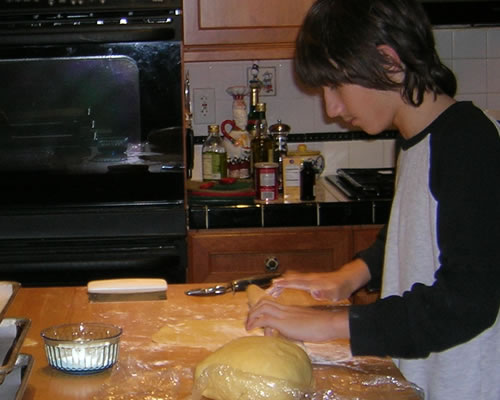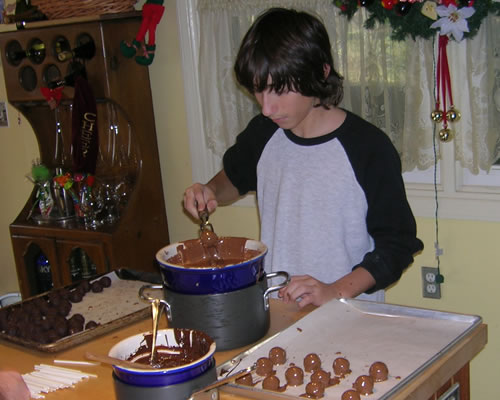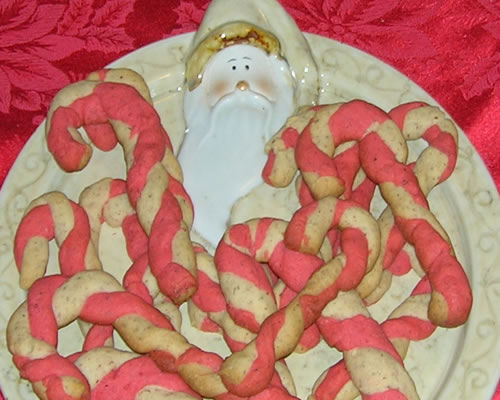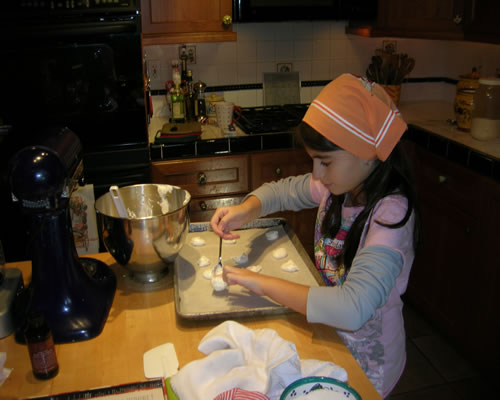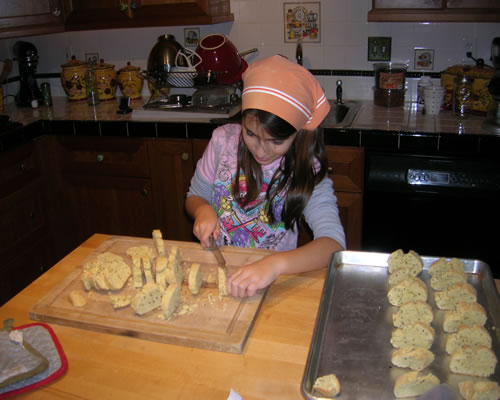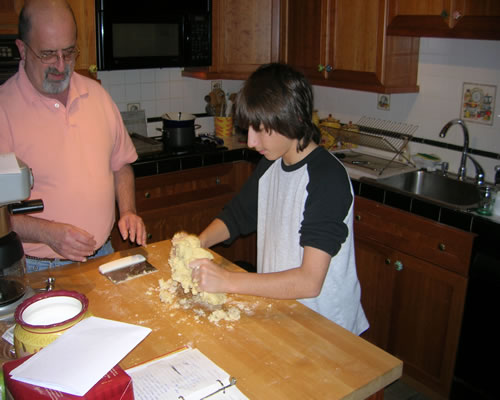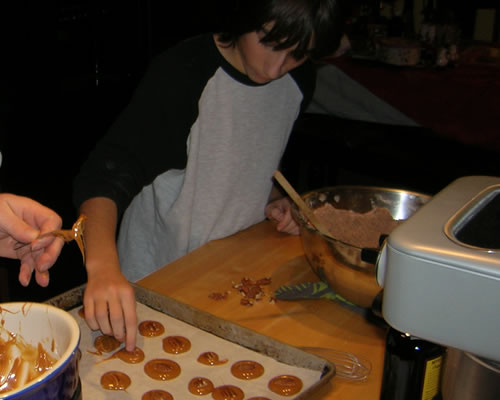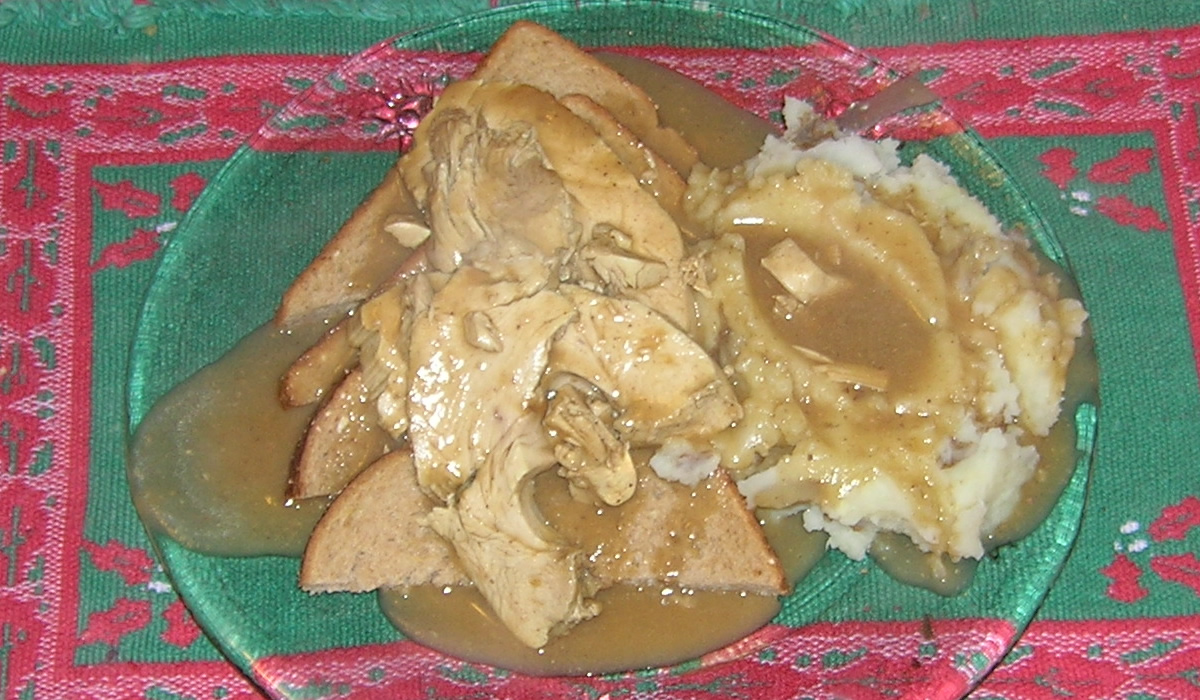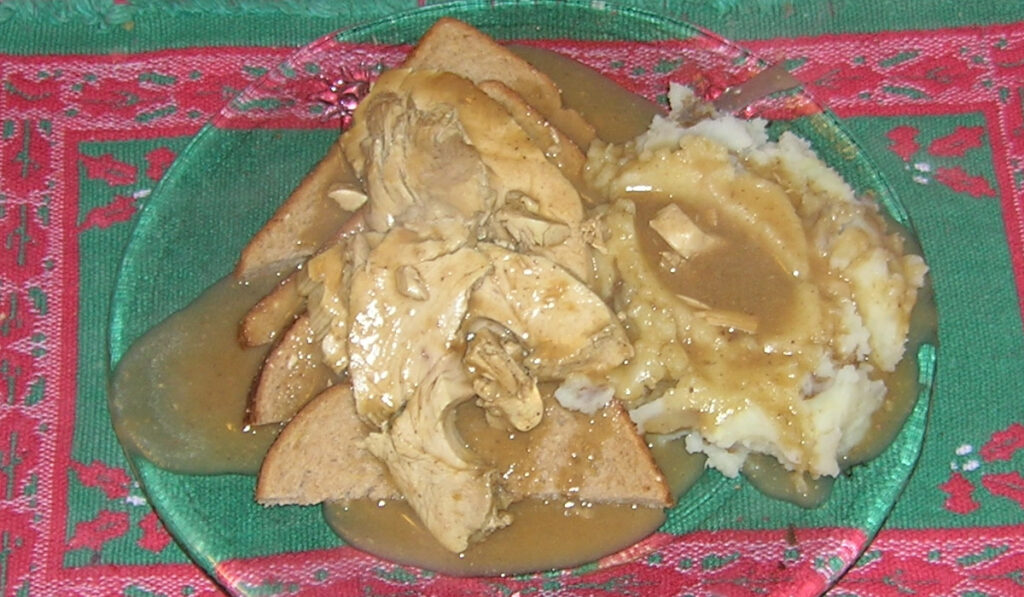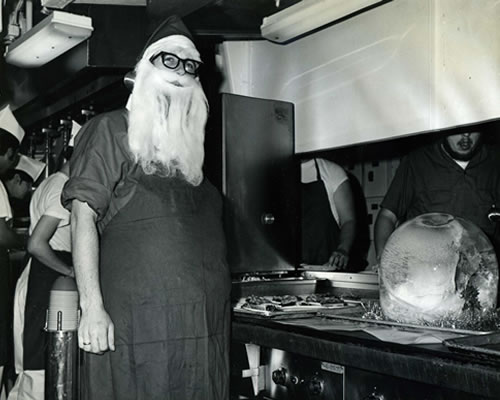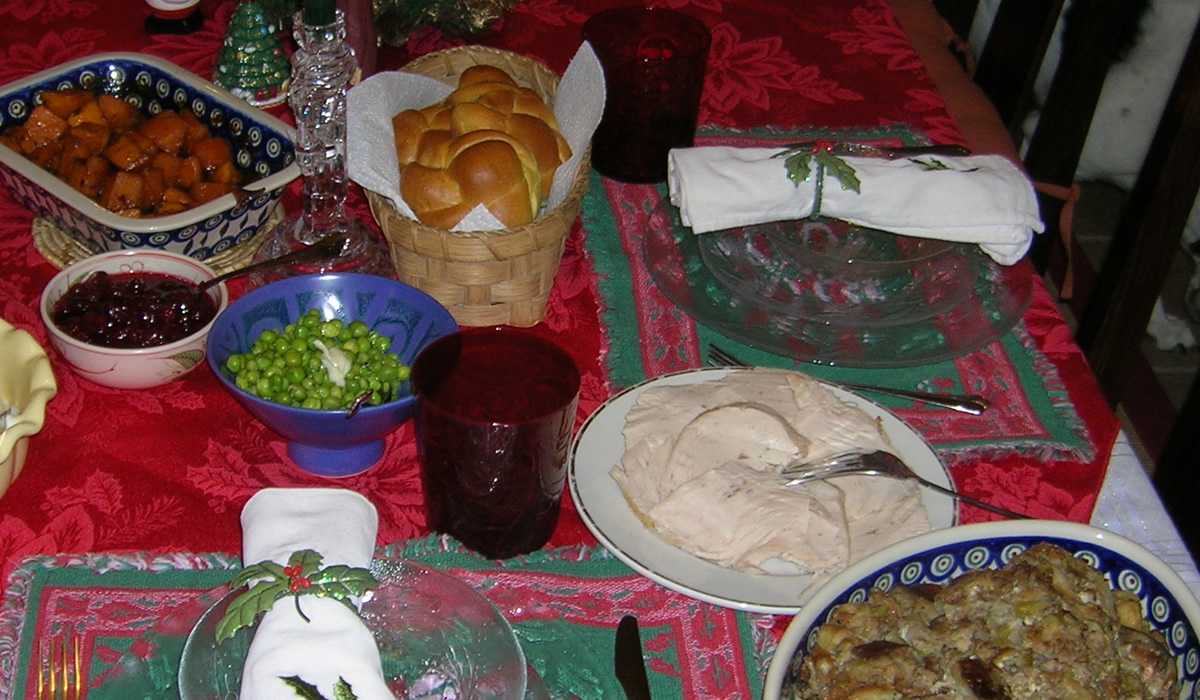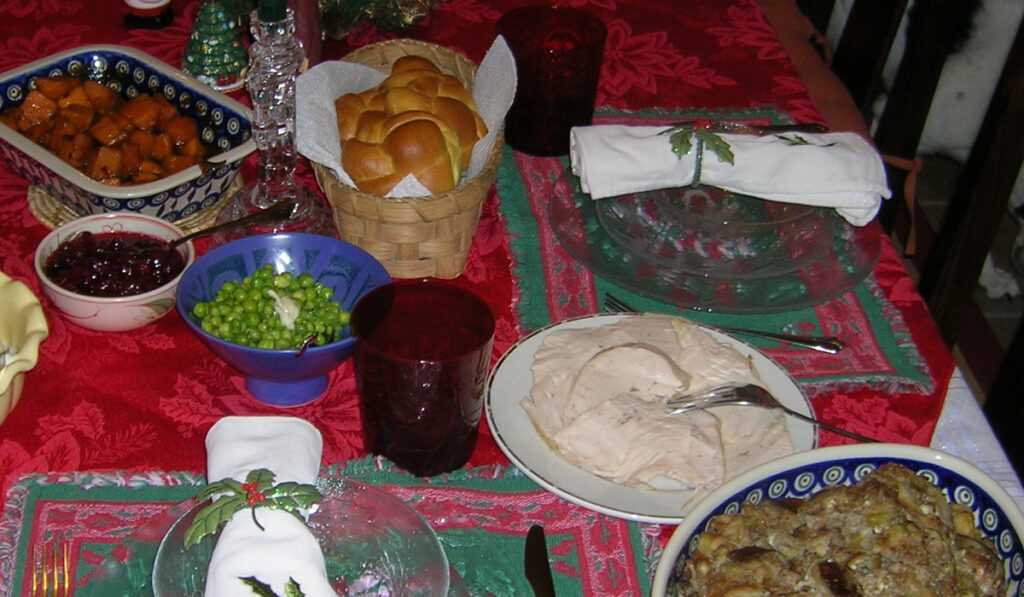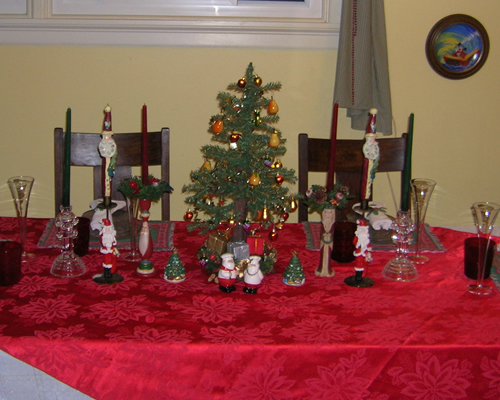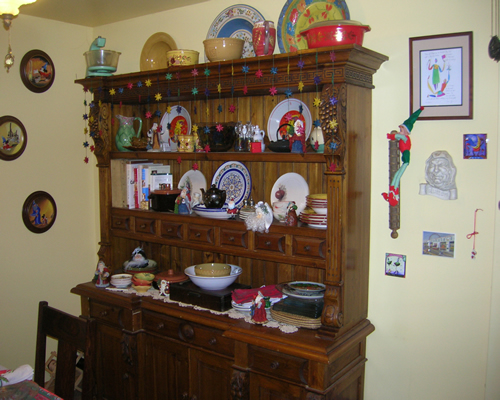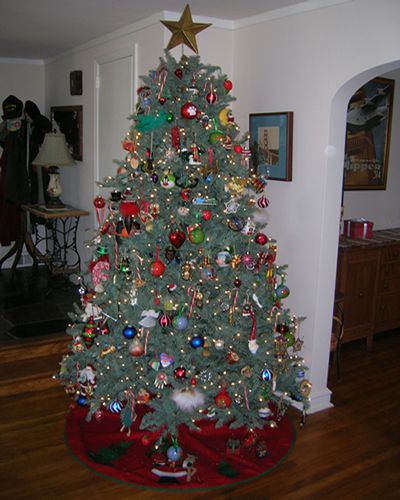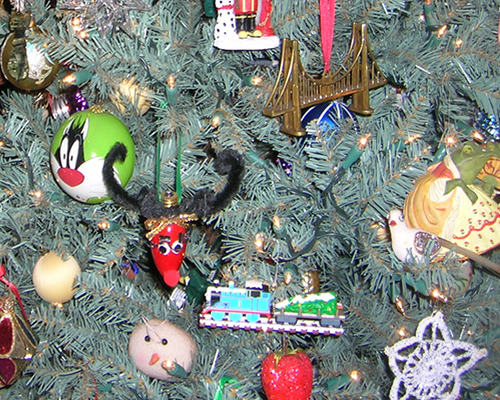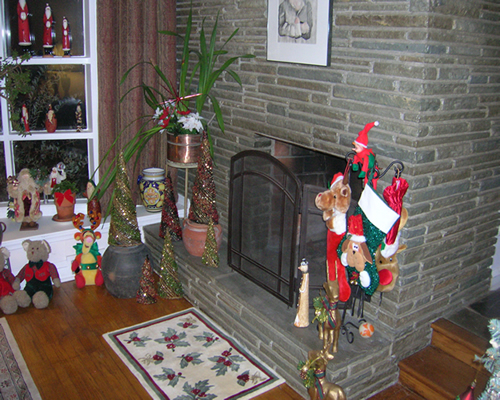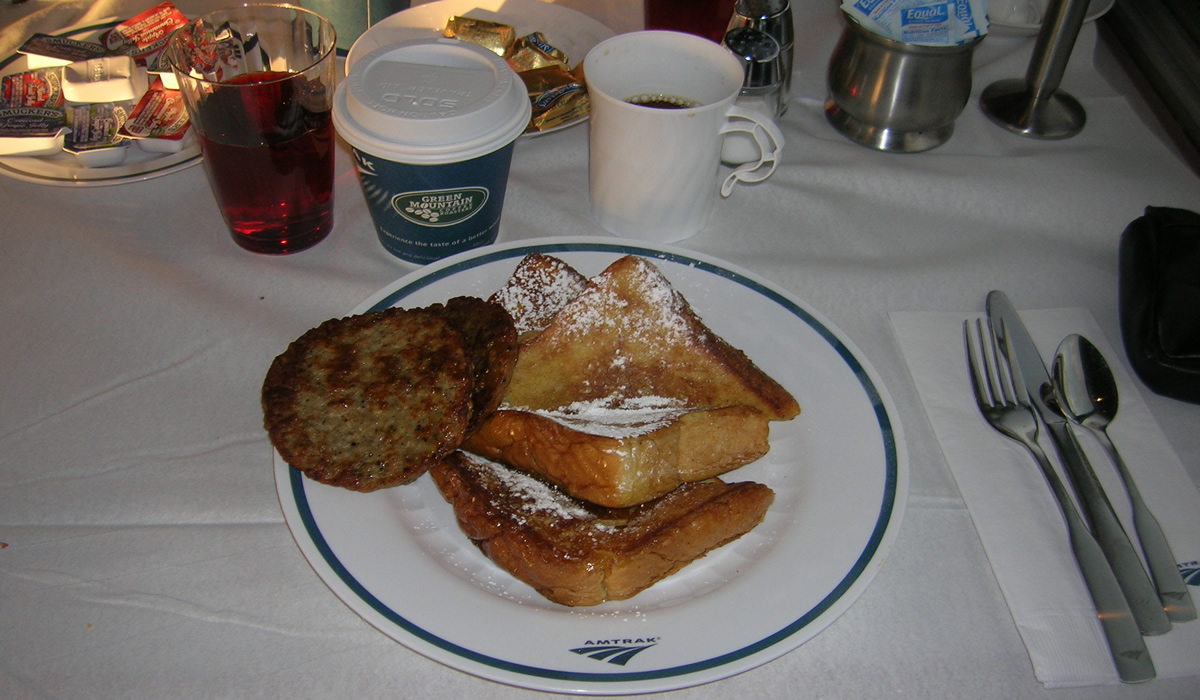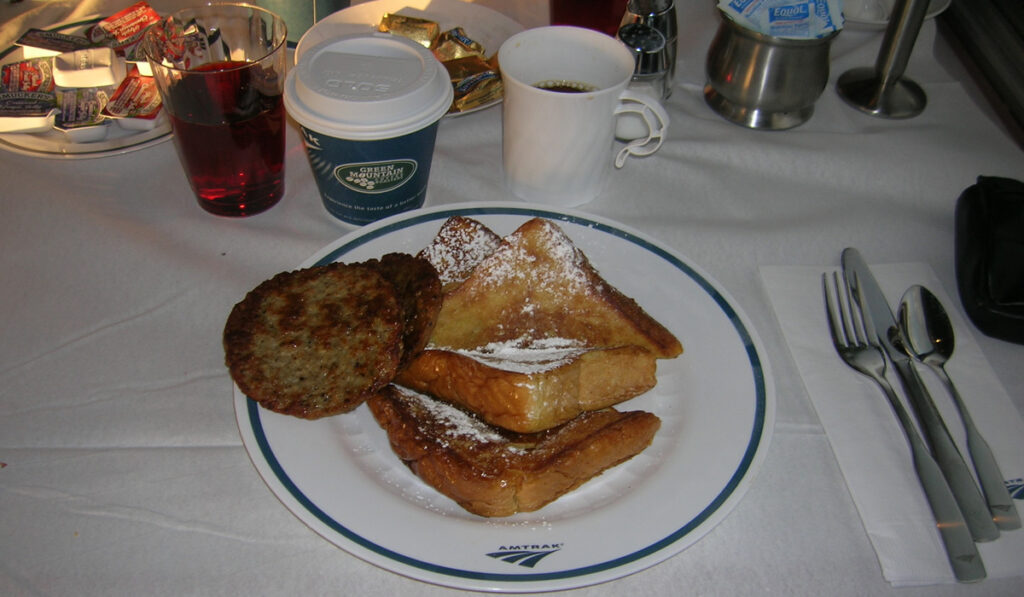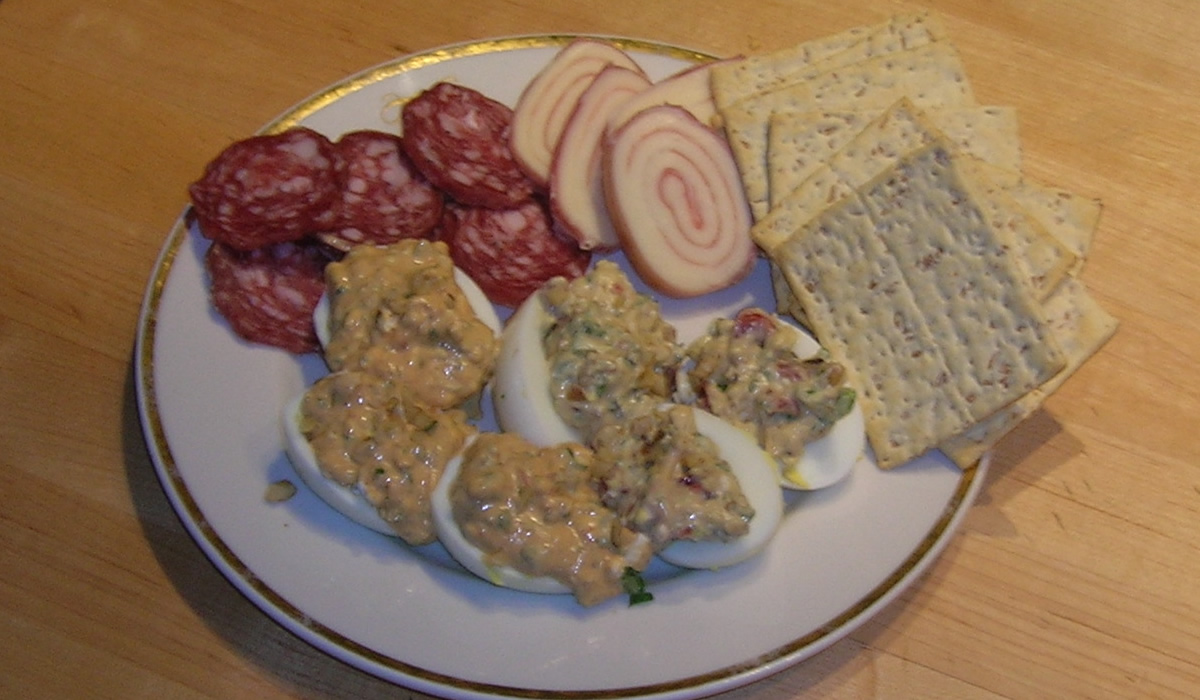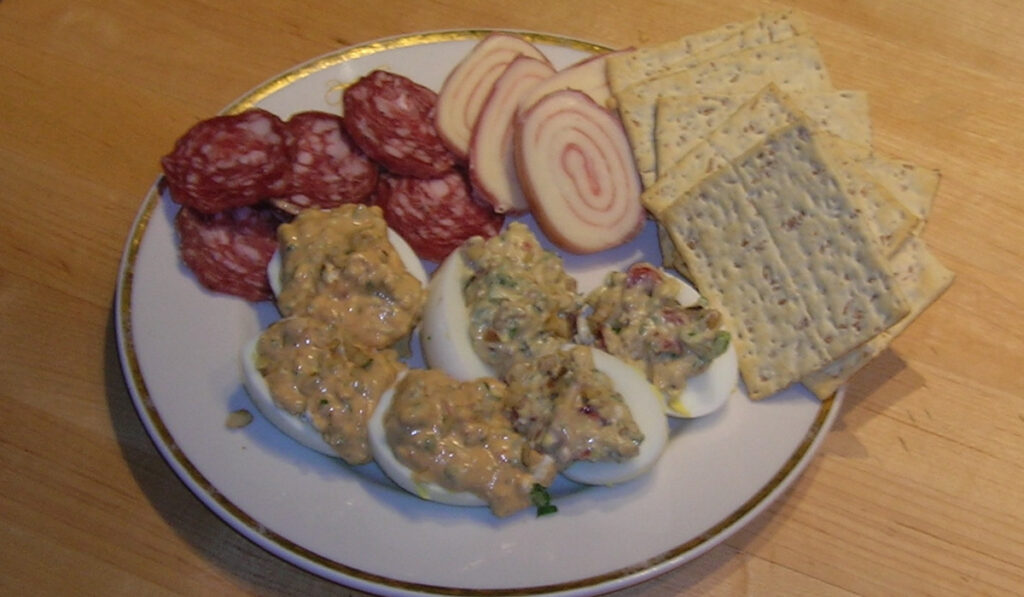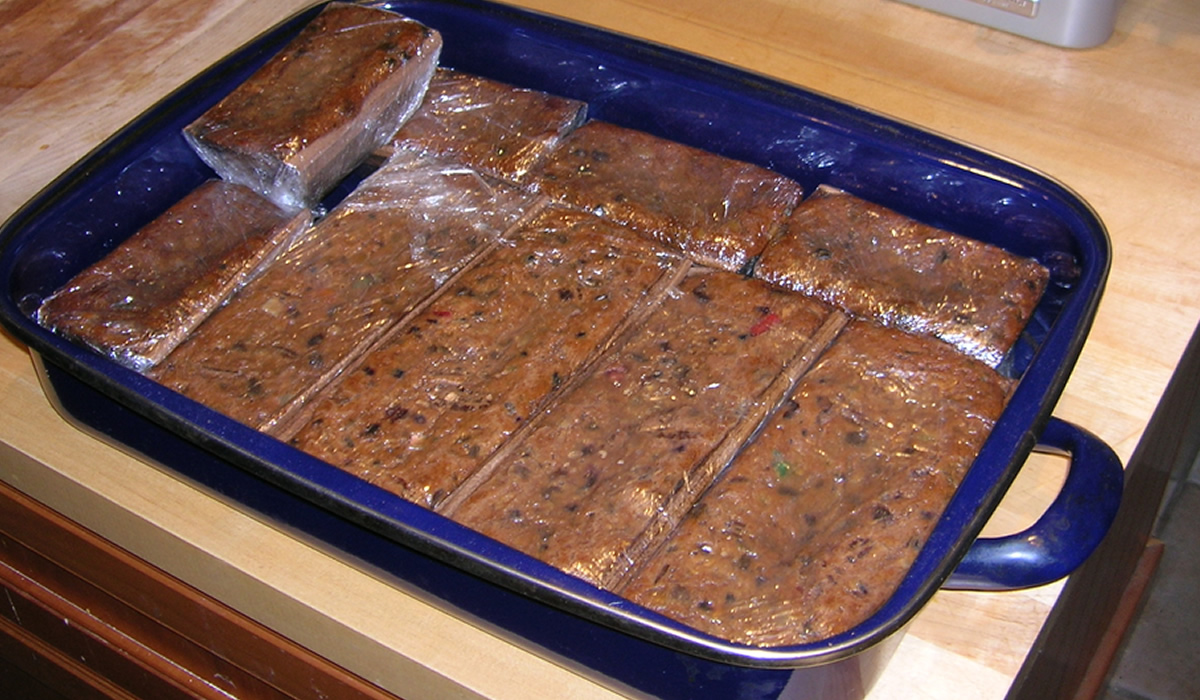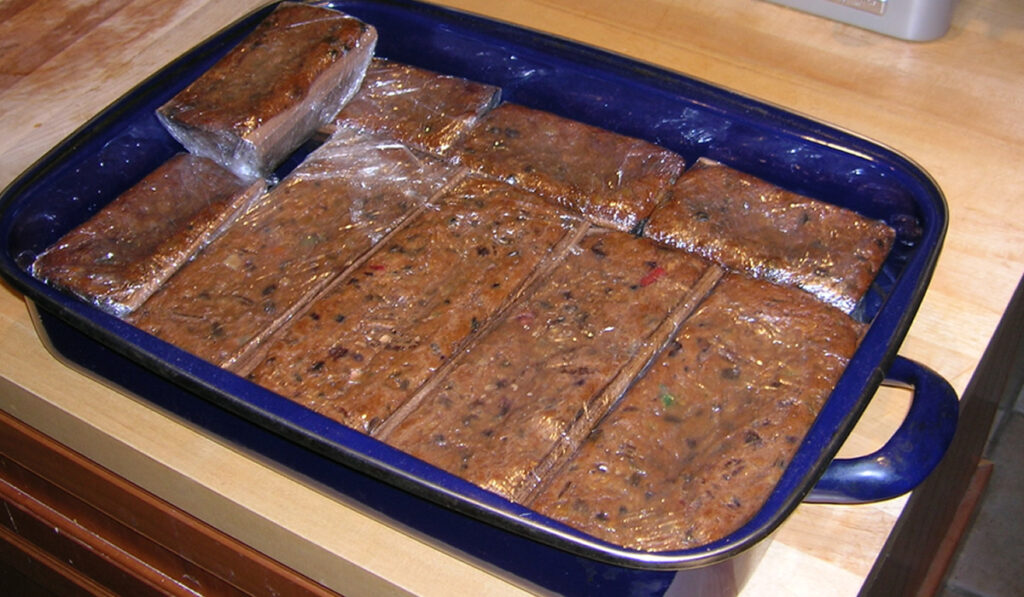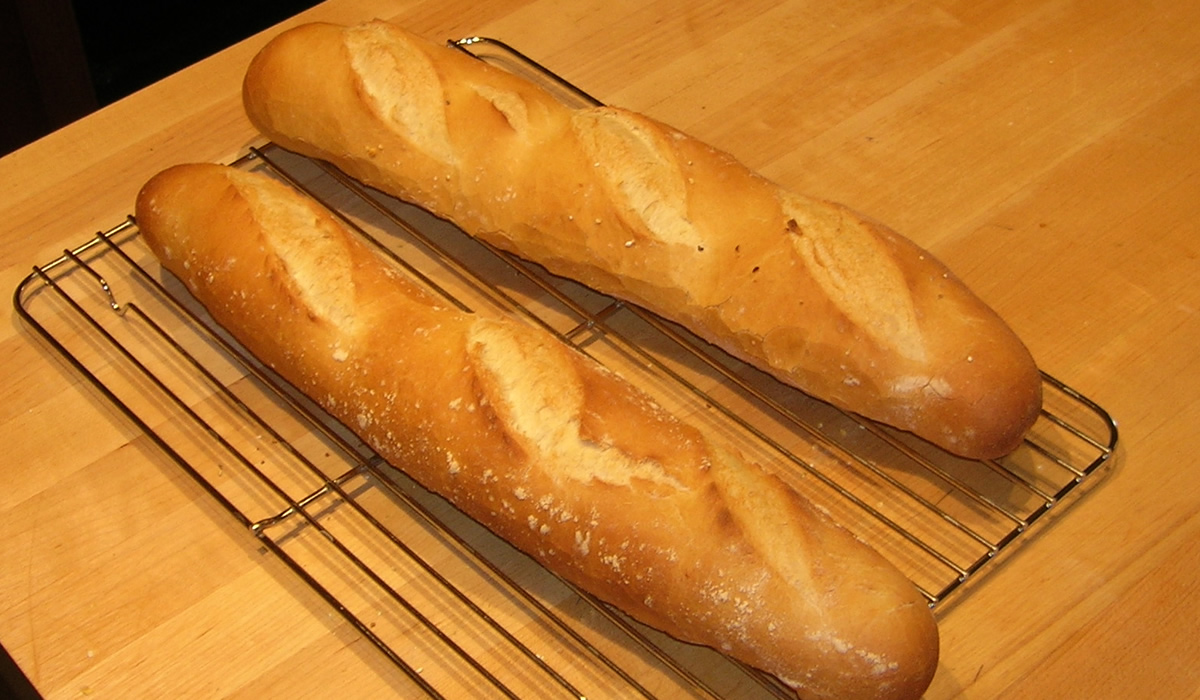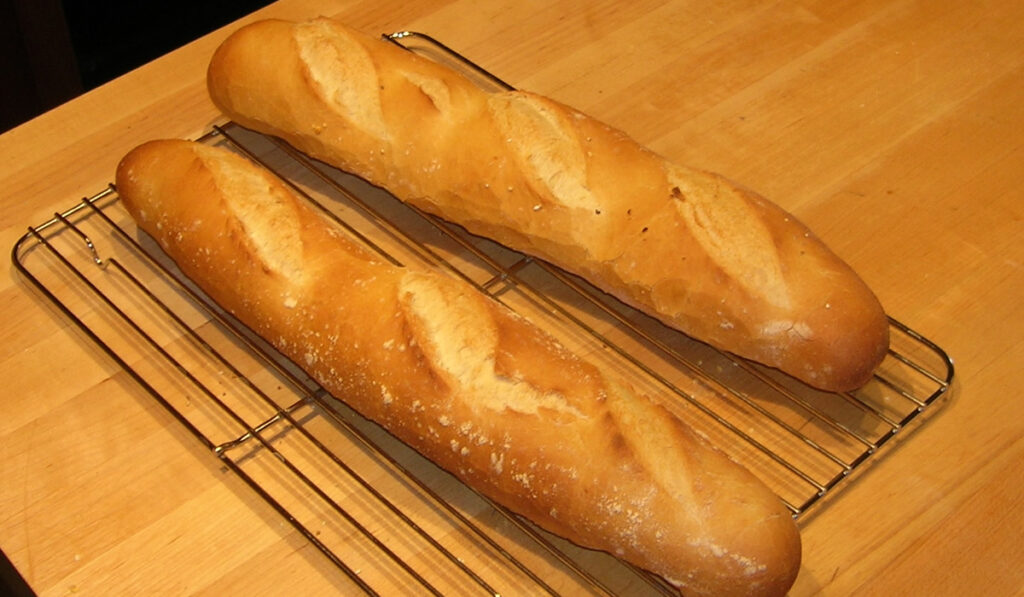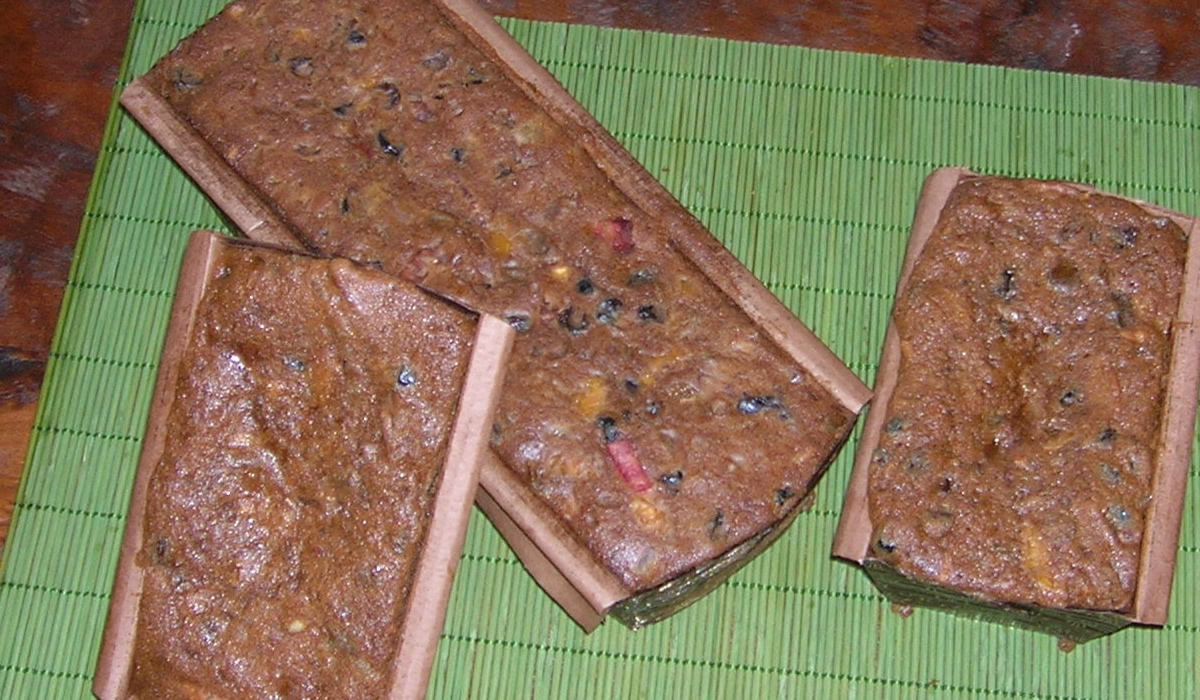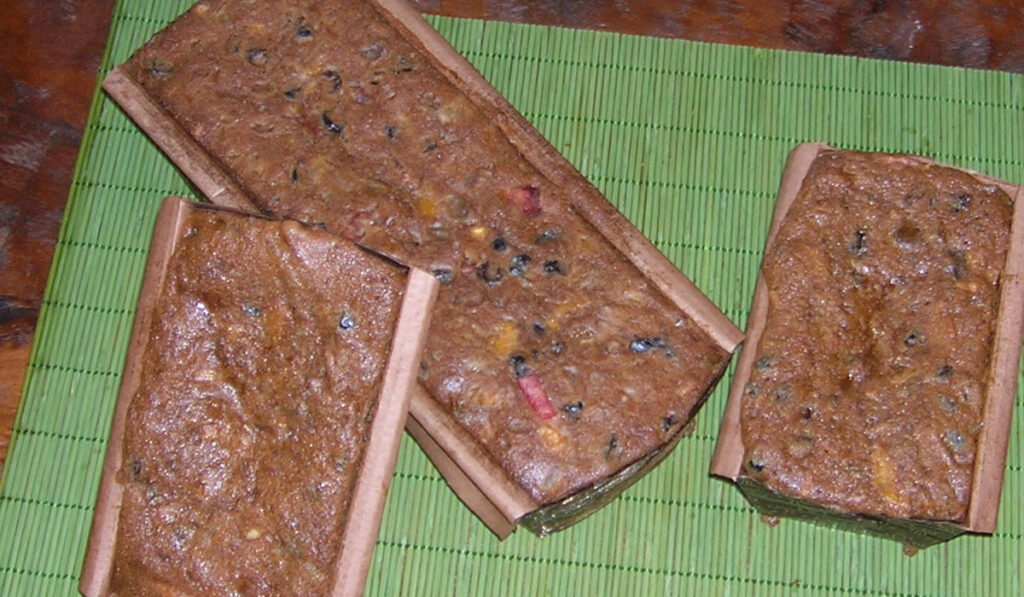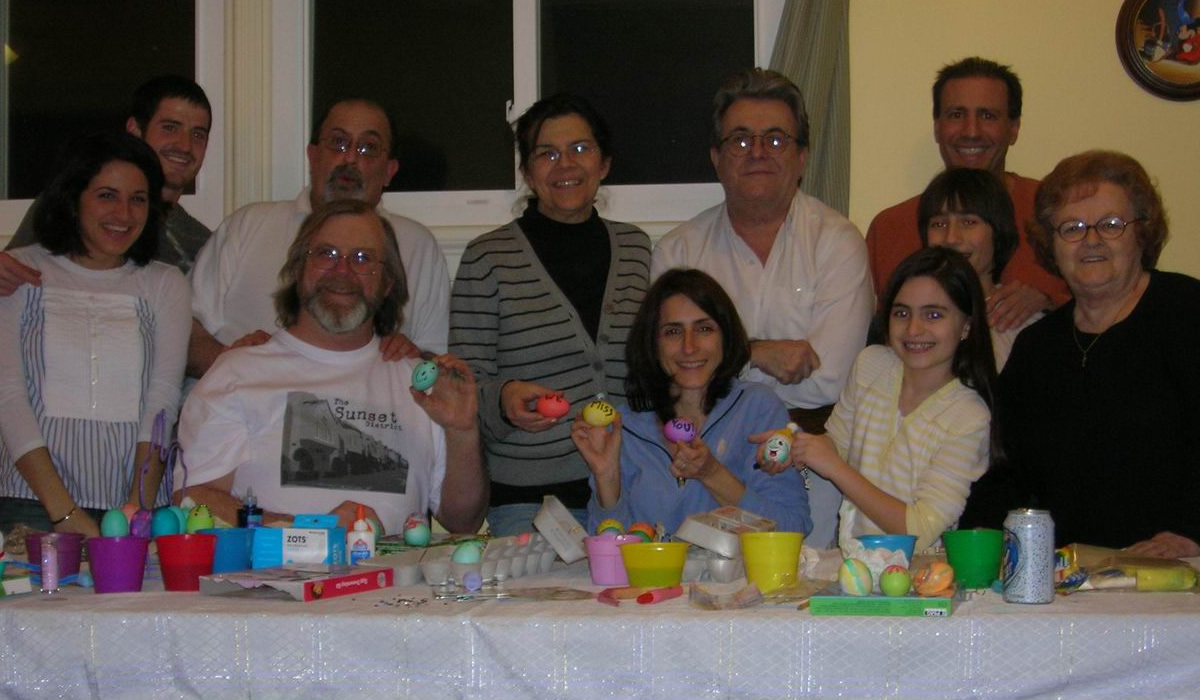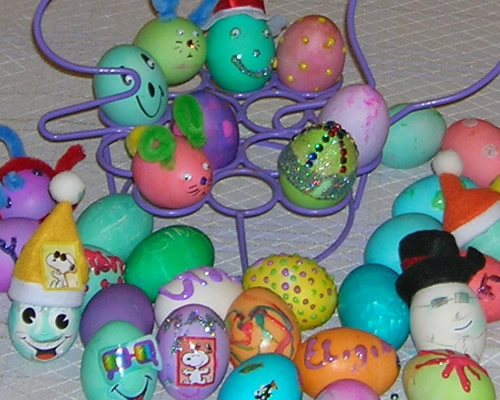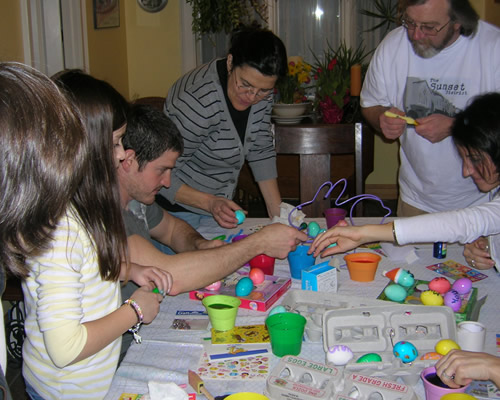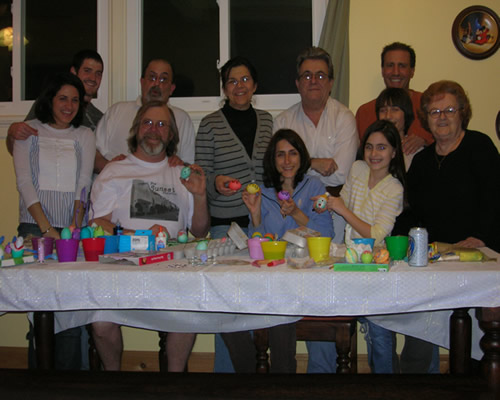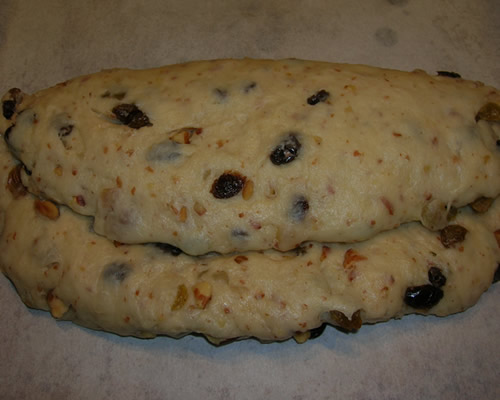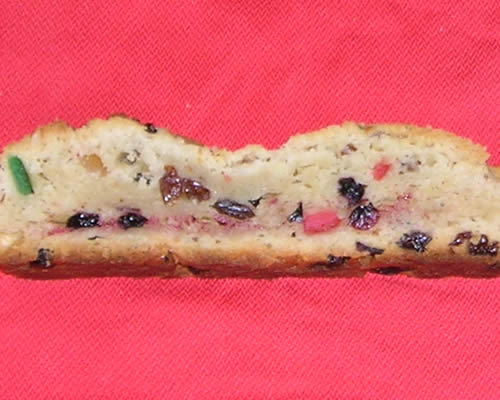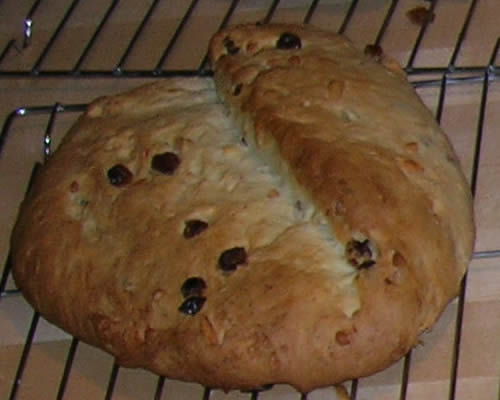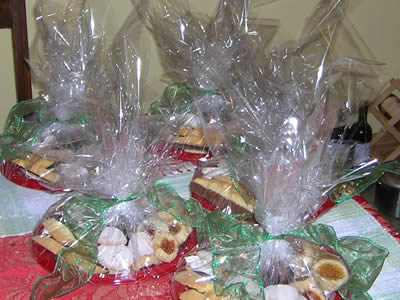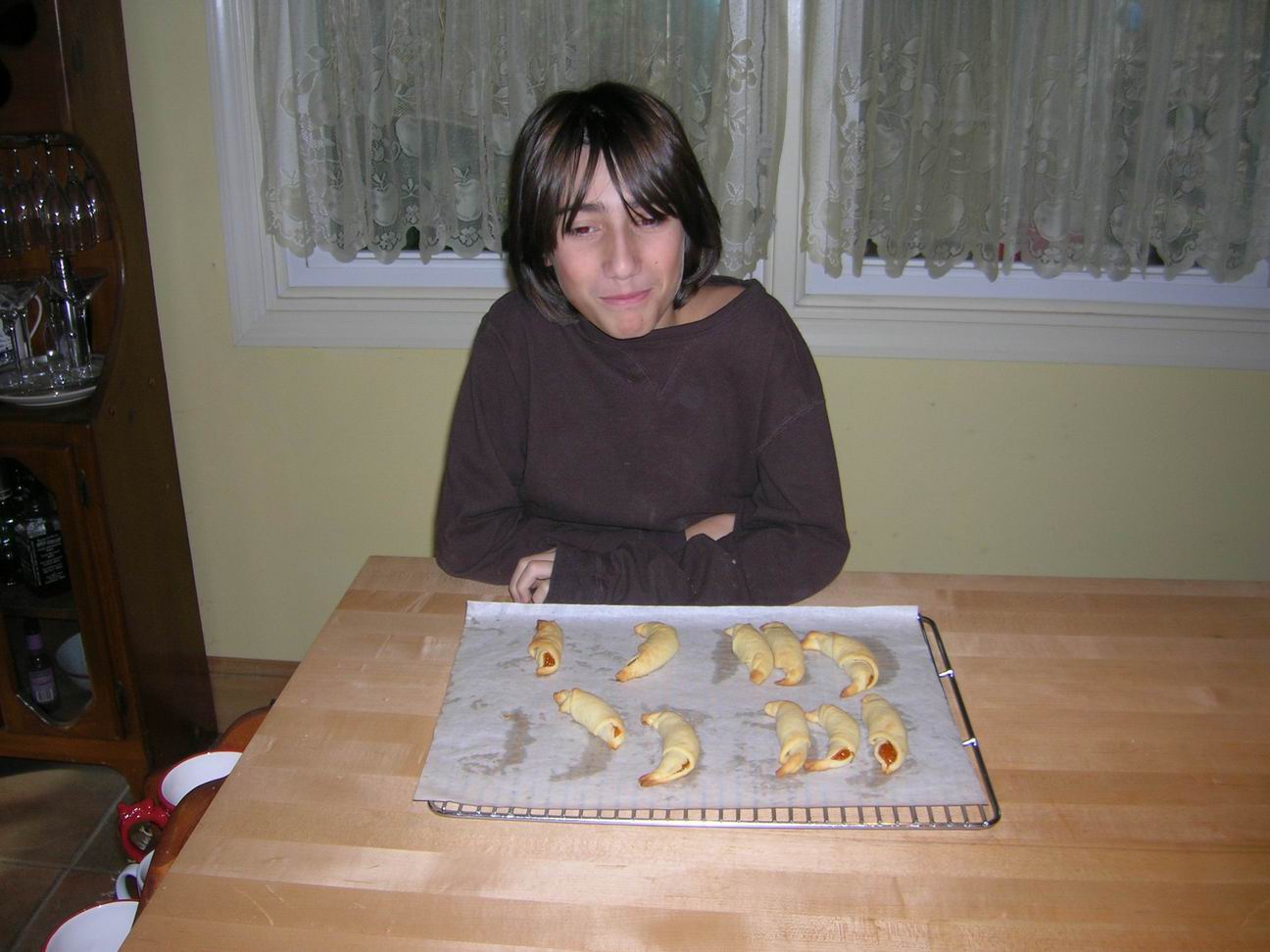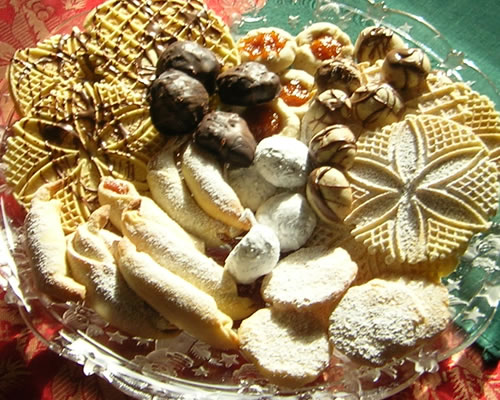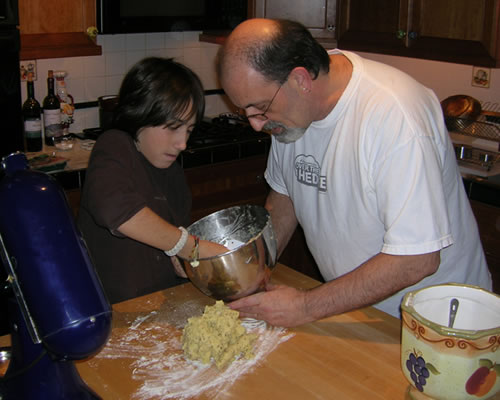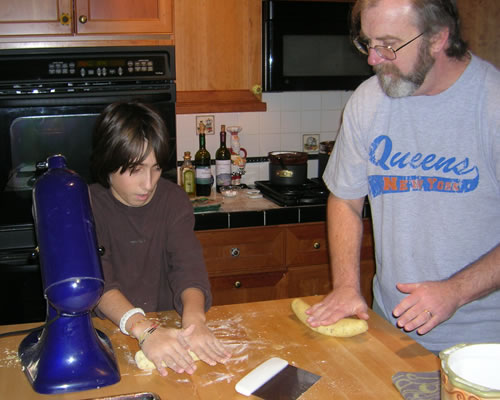It's Beginning To Look A Lot Like Christmas
Definitely beginning to look a lot like Christmas! Cookies and candy everywhere! We were up bright and early this morning and started right off making Aunt Emma's cookies.
Gino started rolling out the dough and then Uncle Tim took over. Uncle Victor and Gino filled and formed. They actually may be the best batch we have made, yet. Gino has the forming down to a science and we had virtually no leakers or splits. (Uncle Tim always has several...) The pastry is perfectly light and flaky, the filling really rich apricot... We did good.
After a nice bacon and egg breakfast, we started in on the biscotti. We made the traditional anise, and will make some others later in the week.
We made a variation of the Christmas Turtles last night, and chocolate-dipped them today. Yum.
And then it was non-stop Rum Ball Rolling-And-Dipping.
It's time for a bit of a breather and then round three (or is it four?!? I love this time of the year!
Christmas Cookies - Part One
'Tis the Season to bake cookies! What started out two years ago as the Boys Cookie-Baking Weekend has morphed into Elizabeth coming over for a while on Saturday to learn some cookie-making, as well.
While I was working, Uncle Victor and Elizabeth made Nonna's biscotti, macaroons, and candy cane cookies.
She did a pretty good job, for a rookie.
Tasty, too!
The girls all left, and we got down to business - the dough for Aunt Emma's cookies. It needs to refrigerate overnight, so Gino got right on it. Well - right after we had Pizza, that is. We do have our priorities.
The secret to the dough is working it with a light hand. You need to learn the feel of the dough. This is Gino's third time making them, now... he's starting to get it.
We also made Aunt Dolores' Rum Ball filling. Alas, when we were halfway done, I found out we didn't have any rum, so while Victor ran to the liquor store, Gino and I finished up the caramel turtles. We'll chocolate-cover them tomorrow.
It is such a blast having them down here.
Thanksgiving is Officially Over
The last of the turkey was consumed tonight. Considering I bought such a (comparitively) small bird this year, I'm surprised it lasted as long as it did.
Hot turkey sandwiches were the appropriate finishing meal. Unfortunately, I forgot the cranberry sauce.
Oh well...
I just had a memory of Turkey Dinner when I was in Uncle Sam's Yacht Club. Christmas Day, 1972... Gulf of Tonkin.
I was a baker and five of us made something like 700 pies, while the cooks in the galley cooked off something like 500 BRT turkeys. (BRT=Boned, Rolled, and Tied.) Mashed potatoes, sweet potatoes, green beans, dressing... The forward bakeshop made 5000 or so dinner rolls. Gourmet, it was not.
So after baking all those damned pies, I got to serve them, as well. I don't remember who sent the Santa outfit to me - one of my sister's probably - but there I was dressed as a pretty lame Santa in a flannel Santa outfit serving those thousands of slices of pie.
The ice mold on the counter there was also a thing to behold. My best buddy Tim - who later became my brother-in-law - and I filled up a small mixing bowl with water and floated plastic holly, tinsel, and lord knows whatever other holiday-type stuff one could find while floating off the coast of Viet Nam. Into the freezer it went, and we had instant holiday ice sculpture. They loved it.
The only thing I really remember well - 36 years after the fact - is just how uncomfortable and hot I was. I think I actually weighed about 150 pounds in that picture and had tons of padding on me. (I wouldn't need the padding, today!) The galley and the bakeshops were always incredibly hot to begin with - and there I was dressed in layers and layers.
And how about those Navy-Issue glasses?!? What a stud.
Happy Thanksgiving, Part Deux
After a great sleep in our own bed last night, I woke early and refreshed - and ready for Thanksgiving Dinner. Of course, that meant shopping. Lancaster County Farmer's Market, here I come. It was great getting down there - my schedule pretty much keeps me from being able to shop down there regularly. I miss not having Wednesday off anymore. I made up for it, today!
First thing I needed was a turkey. I got one about 12 1/2 pounds - almost a third of the size I normally get (last year was 33.3 lbs.) And potatoes, sweet potatoes, fresh peas, rolls, and bread to make my stuffing. I had cranberries in the freezer.
Now... generally, our tradition is we decorate for Christmas the day after Thanksgiving. We've been doing it for 14 years... But... since we neither cooked Thanksgiving or were home, we had to do both today - cook dinner and decorate.
It went really easily. First thing was putting on Christmas Music. I cut up and toasted the bread for the dressing and made the cranberry sauce. While it was cooking away, we brought up decorations from the basement. And brought up decorations. And brought up decorations. We have LOTS of Christmas decorations.
I made a simple sausage stuffing, stuffed the bird, and into the oven it went.
Up went the tree and we started decorating.
And we decorated...
Victor did most of the kitchen...
In between decorating, I'd go back into the kitchen and check on things. I pulled the turkey out and while it was resting, I made the gravy and left it on a low simmer while I did the sweet potatoes. I cubed and boiled them, then after draining them, I added butter, brown sugar, ample syrup, and a pinch of mace and cinnamon. Into the oven they went. Peas were boiled then drained and reheated with a bit of butter, salt and pepper. Made simple mashed potatoes. I almost always leave the skins on the potatoes and mash them up, but Thanksgiving calls for peeled potatoes. It's a rule. And there was only two of us. Two potatoes.
We have lots of fun Kitchen-type decorations. We usually do an apple tree every year and we have several Cooking Santa's...
And then the rest of the house becomes a free-for-all.
I do the dining room. Another tradition. And it never is the same year to year. We've been collecting Santa's for years, but as we were unwrapping stuff today, we realized that somewhere alomng the line, we've started collecting Christmas Trees, as well. No idea how that happened. After Christmas sales, I guess... So... The top of the buffet became a Christmas Tree farm this year.
And there's still another dozen in different places around the house...
The dining room table and chandelier also get over-the-top treatment. Nothing is too gaudy for this room. It's fun.
The tree is the most fun - and the first thing we actually do. Almost every ornament has a story. From family heirlooms to the first ornaments we exchanged, handmade by nieces and nephews, Waterford crystal to paper. Ecclectic doesn't even begin to describe it.
Here's a bit of a closeup...
Here are more Christmas Trees... And Santa's. Since there's no mantle, the stockings get hung with the fireplace poker. Santa understands...
The whole front window is Santa's. Scores of them. Actually, the entire living room is Santa. He's everywhere.We've never counted, but we have lots.
Tomorrow we start outside. And we have a couple of projects we'd like to get to if we have the time and energy. Ya never know.
I boiled the carcass for soup and will make that Monday. Tomorrow night is going to be Apple and Gorgonzola ravioli I bought at the Farmer's Market today. I'm thinking a simple cream sauce. We shall see...
It's great to be home!
Happy Thanksgiving!
Happy Thanksgiving!
Our last breakfast on the California Zephyr was pretty good. We both went for the French Toast. I had sausage patties and Victor went for the bacon.
One more meal on this train and we meet Kate and Lori in Chicago for fast food and a couple of hours of hugs and conversation before boarding our next train to Pittsbutgh.
This has been a really fun ride. I suppose that if we looked, we could find fault with things. It's not exactly four-star dining or sleeping accomodations, but it has been comfortable, the service has been exemplary, and we've met some really fun and interesting people. Things that just don't happen on an airplane.
Yeah... we could find fault if we looked - but why look?
Party Food
I'm working on some party food ideas and wanted a new twist on one of my personal favorites - stuffed eggs.
The poor egg has been so maligned. It is probably the single best protein source there is. Extremely versatile and extremely good tasting. They hold things together, help make cakes rise, and on their own can be a meal in minutes.
I was visiting Paula Deen's website looking for a Pumpkin Pancake recipe and stumbled upon a recipe for some fairly outrageous eggs. I tweaked the recipe a bit, used walnuts instead of pecans, and wondering which chutney I would like the best - tomato or cranberry. Both were good, but the cranberry won.
Outrageous Stuffed Eggs
- 6 hard cooked eggs
- 3 tbsp Chevre cheese
- 3 tbsp Mayonnaise
- 2 tbsp Cranberry Chutney
- 3 tbsp chopped walnuts
- 2 tbsp minced celery
- salt and pepper, to taste
Slice cooked eggs in half. Mix yolks with all the other ingredients. Stuff eggs. Eat.
We're not going to be here for Thanksgiving - we'll be spending it in Chicago with friends waiting to change trains on our cross-country train ride home - so I'll have to remember this for Christmas at Tom & Joanna's. Yum.
Christmas Fruit Cake Update
The fruit cakes have been down in the basement for a month, now... nice and cool, soaking up all that nice brandy... Today, they got yet, another bath...
I didn't make the Apricot Macadamina Nut Fruit Cakes this year. I have a feeling we're going to be cutting back just a bit on our Christmas baking. It's gotten a bit out of control. I'm definitely making the Pfeffernusse, though. YUM!
Actually, we'll probably make as many varieties, just not as many of each. Gino is coming down to help out, again, too.
C'mon, December!
Fresh French Bread
I brought home a ton of cheese yesterday. It happens every time I work the cheese section in the morning. I just go crazy. I want everything and... well... I like cheese. It's one of the most versatile foods in the universe.
I decided that good cheese needed good bread, so I set out this morning to make Julia Child's French Bread. It's a bit of a long recipe...
Pain Francais (French Bread)
(From Mastering the Art of French Cooking: Volume Two by Julia Child and Simone Beck)
Recipe Quantity:
3 - baguettes (24” x 2”) or batards (16” x 3”) or
6 – short loaves, ficelles, 12 – 16” x 2” or
3 – round loaves, boules, 7 – 8” in diameter or
12 – round or oval rolls, petits pains or
1 – large round or oval loaf, pain de menage or miche; pain boulot
Recipe Time: 7 – 9 hours
Additional Information About the Recipe Flour: French bakers make plain French bread out of unbleached flour that has gluten strength of 8 to 9 per cent. Most American all-purpose flour is bleached and has slightly higher gluten content as well as being slightly finer in texture. It is easier to make bread with French flour than with American flour.
Bakers’ Oven Versus Home Ovens: Bakers’ ovens are so constructed that one slides the formed bread dough from a wooden panel right onto the hot, fire-brick oven floor, a steam injection system humidifies the oven for the first few minutes of baking. Steam allows the yeast to work a little longer in the dough and this, combined with the hot baking surface, produced an extra push of volume. In addition, steam coagulating the starch on the surface of the dough gives the crust its characteristic brown color. Although you can produce a good loaf of French bread without steam or a hot baking surface, you will a larger and handsomer loaf when you simulate professional conditions.
Stand Mixer Mixing and Kneading of French Bread Dough: French bread dough is too soft to work in the electric food processor, but the heavy-duty mixer with dough hook works perfectly. The double-hook attachment that comes with some hand held mixers and the hand-cranking bread pails are slower and less efficient, to our mind, than hand kneading. In any case, when you are using electricity, follow the steps in the recipe as outlined, including the rests; do not over-knead and for the heavy duty mixer, do not go over a moderate speed of number 3 or 4, or you risk breaking down the gluten in the dough.
Equipment Needed: Unless you plan to go into the more elaborate simulation of a baker’s oven, you need no unusual equipment for the following recipe. Here are the requirements, some of which may sound odd but will explain themselves when you read the recipe.
- 4 to 5 quart mixing bowl with fairly vertical rather than outward slanting sides
- a kneading surface of some sort, 1 1/2 to 2 square feet
- a rubber spatula or either a metal scraper or a stiff wide metal spatula
- 1 to 2 unwrinkled canvas pastry cloths or stiff linen towels upon which the dough may rise
- a stiff piece of cardboard or plywood 18 – 20 inches long and 6 – 8 inches wide, for unmolding dough from canvas to baking sheet
- finely ground cornmeal or pasta pulverized in an electric blender to sprinkle on unmolding board so as to prevent dough from sticking
- the largest baking sheet that will fit in your oven
- a razor blade or extremely sharp knife for slashing the top of the dough
- a soft pastry brush or fine spray atomizer for moistening dough before and during baking
- a room thermometer to verify rising temperature
Making French Bread:
Step 1: The Dough Mixture – le fraisage (or frasage)
- 1 cake (0.6 ounce) (20grams) fresh yeast or 1 package dry active yeast
- 1/3 cup (75ml) warm water, not over 100 degrees F/38C in a glass measure
- 3 1/2 cup (about 1 lb) (490 gr) all purpose flour, measured by scooping dry measure cups into flour and sweeping off excess
- 2 1/4 tsp (12 gr) salt
- 1 1/4 cups (280 - 300ml) tepid water at 70 – 74 degrees/21 - 23C
Both Methods: Stir the yeast in the 1/3 cup warm water and let liquefy completely while measuring flour into mixing bowl. When yeast has liquefied, pour it into the flour along with the salt and the rest of the water.
Hand Method: Stir and cut the liquids into the flour with a rubber spatula, pressing firmly to form a dough and making sure that all the bits of flour and unmassed pieces are gathered in. Turn dough out onto kneading surface, scraping bowl clean. Dough will be soft and sticky.
Stand Mixer: Combine the ingredients using the dough hook.
Both Methods: Turn dough out onto kneading surface, scraping bowl clean. Dough will be soft and sticky. Let the dough rest for 2 – 3 minutes while you wash and dry the bowl (and the dough hook if using a stand mixer).
Step 2: Kneading – petrissage
The flour will have absorbed the liquid during this short rest, and the dough will have a little more cohesion for the kneading that is about to begin. Use one hand only for kneading and keep the other clean to hold a pastry scrapper, to dip out extra flour, to answer the telephone, and so forth. Your object in kneading is to render the dough perfectly smooth and to work it sufficiently so that all the gluten molecules are moistened and joined together into an interlocking web. You cannot see this happen, of course, but you can feel it because the dough will become elastic and will retract into shape when you push it out.
Hand Method: Start kneading by lifting the near edge of the dough, using a pastry scraper or stiff wide spatula to help you if necessary, and flipping the dough over onto itself. Scrape dough off the surface and slap it down; lift edge and flip it over again, repeating the movement rapidly.
In 2 -3 minutes the dough should have enough body so that you can give it a quick forward push with the heel of your hand as you flip it over.
Continue to knead rapidly and vigorously in this way. If the dough remains too sticky, knead in a sprinkling of flour. The whole kneading process will take 5 – 10 minutes, depending on how expert you become.
Shortly after this point, the dough should have developed enough elasticity so it draws back into shape when pushed, indicating the gluten molecules have united and are under tension like a thin web of rubber; the dough should also begin to clean itself off the kneading surface, although it will stick to your fingers if you hold a pinch of dough for more than a second or two.
Stand Mixer: Knead.
Both Methods: Let dough rest for 3 – 4 minutes. Knead by hand for a minute. The surface should now look smooth; the dough will be less sticky but will still remain soft. It is now ready for its first rise.
Step 3: First Rising – pointage premier temps (3-5 hours at around 70 degrees)
You now have approximately 3 cups of dough that is to rise to 3 1/2 times its original volume, or to about 10 1/2 cups. Wash and fill the mixing bowl with 10 1/2 cups of tepid water (70 – 80 degrees) and make a mark to indicate that level on the outside of the bowl. Note, that the bowl should have fairly upright sides; if they are too outward slanting, the dough will have difficulty in rising. Pour out the water, dry the bowl, and place the dough in it (Mary and Sara Note: Very lightly grease the bowl with butter or kitchen spray as well to prevent the risen dough from sticking to the bowl).
Slip the bowl into a large plastic bag or cover with plastic, and top with a folded bath towel. Set on a wooden surface, marble or stone are too cold. Or on a folded towel or pillow, and let rise free from drafts anyplace where the temperature is around 70 degrees. If the room is too hot, set bowl in water and keep renewing water to maintain around 70 degrees. Dough should take at least 3 – 4 hours to rise to 10 1/2 cups. If temperature is lower than 70 degrees, it will simply take longer.
When fully risen, the dough will be humped into a slight dome, showing that the yeast is still active; it will be light and spongy when pressed. There will usually be some big bubbly blisters on the surface, and if you are using a glass bowl you will see bubbles through the glass.
Step 4: Deflating and Second Rising – rupture; pointage deuxieme temps (1 1/2 to 2 hours at around 70 degrees)
The dough is now ready to be deflated, which will release the yeast engendered gases and redistribute the yeast cells so that the dough will rise again and continue the fermentation process.
With a rubber spatula, dislodge dough from inside of bowl and turn out onto a lightly floured surface, scraping bowl clean. If dough seems damp and sweaty, sprinkle with a tablespoon of flour.
Lightly flour the palms of your hands and flatten the dough firmly but not too roughly into a circle, deflating any gas bubbles by pinching them.
Lift a corner of the near side and flip it down on the far side.
Do the same with the left side, then the right side. Finally, lift the near side and tuck it just under the edge of the far side. The mass of dough will look like a rounded cushion.
Slip the sides of your hands under the dough and return it to the bowl. Cover and let rise again, this time to not quite triple, but again until it is dome shaped and light and spongy when touched.
Step 5: Cutting and resting dough before forming loaves
Loosen dough all around inside of bowl and turn out onto a lightly floured surface. Because of its two long rises, the dough will have much more body. If it seems damp and sweaty, sprinkle lightly with flour.
Making clean, sure cuts with a large knife or a bench scraper, divide the dough into:
- 3 equal pieces for long loaves (baguettes or batards) or small round loaves (boules only)
- 5 – 6 equal pieces for long thin loaves (ficelles)
- 10 – 12 equal pieces for small oval rolls (petits pains, tire-bouchons) or small round rolls (petits pains, champignons)
- 2 equal pieces for medium round loaves (pain de menage or miche only)
- If you making one large round loaf (pain de menage, miche, or pain boulot), you will not cut the dough at all and just need to follow the directions below.
After you have cut each piece, lift one end and flip it over onto the opposite end to fold the dough into two; place dough at far side of kneading surface. Cover loosely with a sheet of plastic and let rest for 5 minutes before forming. This relaxes the gluten enough for shaping but not long enough for dough to begin rising again.
While the dough is resting, prepare the rising surface; smooth the canvas or linen towelling on a large tray or baking sheet, and rub flour thoroughly into the entire surface of the cloth to prevent the dough from sticking
Step 6: Forming the loaves – la tourne; la mise en forme des patons
Because French bread stands free in the oven and is not baked in a pan, it has to be formed in such a way that the tension of the coagulated gluten cloak on the surface will hold the dough in shape.
For Long Loaves - The Batard: (Baguettes are typically much too long for home ovens but the shaping method is the same)
After the 3 pieces of dough have rested 5 minutes, form one piece at a time, keeping the remaining ones covered.
Working rapidly, turn the dough upside down on a lightly floured kneading surface and pat it firmly but not too roughly into an 8 to 10 inch oval with the lightly floured palms of your hands. Deflate any gas bubbles in the dough by pinching them.
Fold the dough in half lengthwise by bringing the far edge down over the near edge.
Being sure that the working surface is always lightly floured so the dough will not stick and tear, which would break the lightly coagulated gluten cloak that is being formed, seal the edges of the dough together, your hands extended, thumbs out at right angles and touching.
Roll the dough a quarter turn forward so the seal is on top.
Flatten the dough again into an oval with the palms of your hands.
Press a trench along the central length of the oval with the side of one hand.
Fold in half again lengthwise.
This time seal the edges together with the heel of one hand, and roll the dough a quarter of a turn toward you so the seal is on the bottom.
Now, by rolling the dough back and forth with the palms of your hands, you will lengthen it into a sausage shape. Start in the middle, placing your right palm on the dough, and your left palm on top of your right hand.
Roll the dough forward and backward rapidly, gradually sliding your hands towards the two ends as the dough lengthens.
Deflate any gas blisters on the surface by pinching them. Repeat the rolling movement rapidly several times until the dough is 16 inches long, or whatever length will fit on your baking sheet. During the extension rolls, keep circumference of dough as even as possible and try to start each roll with the sealed side of the dough down, twisting the rope of dough to straighten the line of seal as necessary. If seal disappears, as it sometimes does with all purpose flour, do not worry.
Place the shaped piece of dough, sealed side up, at one end of the flour rubbed canvas, leaving a free end of canvas 3 to 4 inches wide.
The top will crust slightly as the dough rises; it is turned over for baking so the soft, smooth underside will be uppermost.
Pinch a ridge 2 1/2 to 3 inches high in the canvas to make a trough, and a place for the next piece. Cover dough with plastic while you are forming the rest of the loaves.
After all the pieces of dough are in place, brace the two sides of the canvas with long rolling pins, baking sheets or books, if the dough seems very soft and wants to spread out. Cover the dough loosely with flour rubbed dish towel or canvas, and a sheet of plastic. Proceed immediately to the final rising, next step.
For Long Thin Loaves – Fincelles: Follow the steps above but making thinner sausage shapes about 1/2 inch in diameter. When they have risen, slash as with the Batard.
For Oval Rolls – Petits Pains, Tire-Bouchons: Form like batards, but you will probably not have to lengthen them at all after the two foldings and sealings. Place rolls on a floured canvas about 2 – 4” apart and cover with plastic to rise. When they have risen, make either 2 parallel slashes or a single slash going from one end to the other.
For Small, Medium, or Large Round Loaves – Pain de Menage, Miches, Boules: The object here is to force the cloak of coagulated gluten to hold the ball of dough in shape: the first movement will make cushion; the second will seal and round the ball, establishing surface tension.
Place the dough on a lightly floured surface.
Lift the left side of the dough with the side of your left hand and bring it down almost to the right side.
Scoop up the right side and push it back almost to the left side. Turn the dough a quarter turn clockwise and repeat the movement 8 – 10 times. The movement gradually smooths the bottom of the dough and establishes the necessary surface tension; think of the surface of the dough as if it were a fine sheet of rubber you were stretching in every direction.
Turn the dough smooth side up and begin rotating it between the palms of your hands, tucking a bit of the dough under the ball as you rotate it. In a dozen turns you should have a neatly shaped ball with a little pucker of dough, le cle, underneath where all the edges have joined together.
Place the dough pucker side up in a flour-rubbed canvas; seal the pucker by pinching with your fingers. Flour lightly, cover loosely and let rise to almost triple its size. After unmolding upside down on the baking sheet, slash with either a long central slash, two long central slashes that cross at right angles, or a semi-circular slash around half the circumference.
For Small Round Rolls – Petits Pains, Champignons: The principles are the same here as for the preceding round loaves, but make the cushion shape with your fingers rather than the palms of your hands.
For the second stage, during which the ball of dough is rotated smooth side up, roll it under the palm of one hand, using your thumb and little finger to push the edges of the dough underneath and to form the pucker, where the edges join together
Place the formed ball of dough pucker side up on the flour rubbed canvas and cover loosely while forming the rest. Space the balls 2 inches apart. When risen to almost triple its size, lift gently with lightly floured fingers and place pucker side down on baking sheet. Rolls are usually too small for a cross so make either one central slash or the semi-circular cut.
For Large Oval Loaf – Pain Boulot: Follow the directions for the round loaves except instead of rotating between the balms of your hands and tucking to form a round loaf, continue to turn the dough from the right to the left, tucking a bit of each end under the oblong loaf. In a dozen turns you should have a neatly shaped oval with tow little puckers of dough, le cles, underneath where all the edges of have joined together.
Place the dough pucker sides up in a flour-rubbed canvas; seal the puckers by pinching with your fingers. Flour lightly, cover loosely and let rise to almost triple its size. After unmolding upside down on the baking sheet, slash with parallel slashes going diagonally across the top starting from the upper left and going to the lower right.
Step 7: Final Rise – l’appret - 1 1/2 to 2 1/2 hours at around 70 degrees
The covered dough is now to rise until almost triple in volume; look carefully at its pre-risen size so that you will be able to judge correctly. It will be light and swollen when risen, but will still feel a little springy when pressed.
It is important that the final rise take place where it is dry; if your kitchen is damp, hot, and steamy, let the bread rise in another room or dough will stick to the canvas and you will have difficulty getting it off and onto another baking sheet. It will turn into bread in the oven whatever happens, but you will have an easier time and a better loaf if you aim for ideal conditions.
Preheat oven to 450 degrees about 30 minutes before estimated baking time.
Step 8: Unmolding risen dough onto baking sheet – le demoulage.
The 3 pieces of risen dough are now to be unmolded from the canvas and arranged upside down on the baking sheet. The reason for this reversal is that the present top of the dough has crusted over during its rise; the smooth, soft underside should be uppermost in the oven so that the dough can expand and allow the loaf its final puff of volume. For the unmolding you will need a non-sticking intermediate surface such as a stiff piece of cardboard or plywood sprinkled with cornmeal or pulverized pasta.
Remove rolling pins or braces. Place the long side of the board at one side of the dough; pull the edge of the canvas to flatten it; then raise and flip the dough softly upside down onto the board.
Dough is now lying along one edge of the unmolding board: rest this edge on the right side of a lightly buttered baking sheet. Gently dislodge dough onto baking sheet, keeping same side of the dough uppermost: this is the soft smooth side, which was underneath while dough rose on canvas. If necessary run sides of hands lightly down the length of the dough to straighten it. Unmold the next piece of dough the same way, placing it to the left of the first, leaving a 3 inch space. Unmold the final piece near the left side of the sheet.
Step 9: Slashing top of the dough – la coupe.
The top of each piece of dough is now to be slashed in several places. This opens the covering cloak of gluten and allows a bulge of dough underneath to swell up through the cuts during the first 10 minutes of baking, making decorative patterns in the crust. These are done with a blade that cuts almost horizontally into the dough to a depth of less than half an inch. Start the cut at the middle of the blade, drawing toward you in a swift clean sweep. This is not quite as easy as it sounds, and you will probably make ragged cuts at first; never mind, you will improve with practice. Use an ordinary razor blade and slide one side of it into a cork for safety; or buy a barbers straight razor at a cutlery store.
For a 16 to 18 inch loaf make 3 slashes. Note that those at the two ends go straight down the loaf but are slightly off centre, while the middle slash is at a slight angle between the two. Make the first cut at the far end, then the middle cut, and finally the third. Remember that the blade should lie almost parallel to the surface of the dough.
Step 10: Baking – about 25 minutes; oven preheated to 450 degrees (230 degrees C).
As soon as the dough has been slashed, moisten the surface either by painting with a soft brush dipped in cold water, or with a fine spray atomizer, and slide the baking sheet onto rack in upper third of preheated oven. Rapidly paint or spray dough with cold water after 3 minutes, again in 3 minutes, and a final time 3 minutes later. Moistening the dough at this point helps the crust to brown and allows the yeast action to continue in the dough a little longer. The bread should be done in about 25 minutes; the crust will be crisp, and the bread will make a hollow sound when thumped.
If you want the crust to shine, paint lightly with a brush dipped in cold water as soon as you slide the baking sheet out of oven.
Step 11: Cooling – 2 to 3 hours.
Cool the bread on a rack or set it upright in a basket or large bowl so that air can circulate freely around each piece. Although bread is always exciting to eat fresh from the oven, it will have a much better taste when the inside is thoroughly cool and has composed itself.
Step 12: Storing French bread
Because it contains no fats or preservatives of any kind, French bread is at its best when eaten the day it is baked. It will keep for a day or two longer, wrapped airtight and refrigerated, but it will keep best if you freeze it – let the loaves cool first, then wrap airtight. To thaw, unwrap and place on a baking sheet in a cold oven; heat the oven to 400 degrees. In about 20 minutes the crust will be hot and crisp, and the bread thawed. The French, of course, never heat French bread except possibly on Monday, the baker’s holiday, when the bread is a day old.
Step 13: Canvas housekeeping
After each bread session, if you have used canvas, brush it thoroughly to remove all traces of flour and hang it out to dry before putting away. Otherwise the canvas could become mouldy and ruin your next batch of dough.
The Simulated Bakers’ Oven
Baking in the ordinary way, as described in the preceding recipe, produces an acceptable loaf of bread but does not nearly approach the glory you can achieve when you turn your home oven into a baker’s oven. Merely providing yourself with the proper amount of steam, if you can do nothing else, will vastly improve the crust, the color, the slash patterns, and the volume of your bread; steam is only a matter of plopping a heated brick or stone into a pan of water in the bottom of the oven. The second provision is a hot surface upon which the naked dough can bake; this gives that added push of volume that improves both the appearance and the slash patterns. When you have the hot baking surface, you will then also need a paddle or board upon which you can transfer dough from canvas to hot baking surface. For the complete set up here is you should have, and any building-supply store stocks these items.
For the hot baking surface: Metal will not do as a hot baking surface because it burns the bottom of the dough. The most practical and easily obtainable substance is ordinary red floor tiles 1/4” thick. They come in various sizes such as 6 x 6, 6 x 3, and you only need enough to line the surface of an oven rack. Look them up under Tiles in your Directory, and ask for “quarry tiles” their official name.
For unmolding the risen dough from its canvas: A piece of 3/16 inch plywood about 20 inches wide.
For sliding the dough onto the hot tiles: When you are doing 3 long loaves, you must slide them together onto the hot tiles; to do so you unmold them one at a time with one board and arrange them side by side on the second board, which takes place on the baker’s paddle, la pelle. Buy a piece of plywood slightly longer but 2 inches narrower than your oven rack.
To prevent dough from sticking to unmolding and sliding boards: White cornmeal or small dried pasta pulverized in the electric blender until it is the consistency of table salt. This is called fleurage.
The steam contraption: Something that you can heat to sizzling hot on top of the stove and then slide into a pan of water in the oven to make a great burst of steam: a brick, a solid 10lb rock, piece of cast iron or other metal. A 9 x 12 inch roasting pan 2 inches deep to hold an inch of water and the hot brick.
+++++++++++++++++++++++++
Okay. Did you get all that?!?
Julia did make this sound a bit more complex that it actually is. On the other hand, I've made a few (thousand) loaves of bread in my time and am not intimidated by long sets of instructions. It's only bread. The ingredients are still relatively inexpensive. The very worst thing that could happen is it wouldn't be as good as Julia's. Oh well.
But... not to worry. The bread was every bit as good as Julia would have baked, and I know she would have enjoyed a slice or two.
Now... getting back to that cheese...
I did mention I went a little crazy with the cheeses... We had:
- Triple Cream Brie
- Saint Andre
- 3 kinds of chevere (plain, 4 pepper, and garlic and herb)
- 3-year-aged Cheddar
- Cotswold (A double Glouster with onions and chives)
- Blue Castello
And I grilled a flank steak and served thin slices of steak with the cheeses and bread. Tres fabu!
Oh. And while I was waiting for dough to rise this morning, I made the first Pumpkin Pies of the season!
Perfect Pumpkin Pie
- 3/4 cup granulated sugar
- 1/2 teaspoon salt
- 2 teaspoon ground cinnamon
- 1/2 teaspoon ground ginger
- 1/4 teaspoon ground cloves
- 1/4 teaspoon freshly ground nutmeg
- 2 large eggs
- 1 can (15 oz.) pumpkin
- 1 can (12 fl. oz.) evaporated milk
- 1 unbaked 10" pie shell
- Whipped cream
Preheat oven to 425°. Beat eggs, sugar, and spices in large bowl. Add pumpkin amd mix well. Gradually stir in evaporated milk.
Pour into pie shell. Bake at 425° for 15 minutes. Reduce temperature to 350° and bake for 40 to 50 minutes or until knife inserted near center comes out clean. Top with whipped cream before serving.
I topped mine with a ginger whipped cream.
I shall not be eating anything more today.
Christmas Fruitcake
The 2008 Christmas Baking Season has officially started! Today, I started off with fruitcake. This is a new recipe for me, and it looks pretty good.
I absolutely love real, homemade fruitcake. If you've only tasted those nasty doorstops sold in grocery stores, you're in for a treat. There is a difference. REAL fruitcake is good.
Fruit Cake
The recipe makes several fruitcakes and will require a couple of pretty big bowls.
- 1 lb butter
- 1 lb light brown sugar
- 9 eggs
- 2 tbsp milk
- 1 lb flour
- 1 tsp baking soda
- 2 tsp mace
- 1 tbsp cinnamon
- 2 lbs dried currants
- 1 lb raisins
- 1 lb golden raisins
- 1 lb glace fruits
- 8 oz glace pineapple, cut into bite size pieces
- 1 lb whole pecans
Preheat oven to 275°. Place dried fruits into large bowl, mix in glace fruits, add 1/4 cup liquor, mix well, and set aside. (Can be prepared the night before.)
Separate the eggs. Beat egg whites until stiff with half of the brown sugar, set aside. Cream butter, adding half the brown sugar, mix well. Beat the egg yolks until thick, beat yolks into butter mixture, along with the milk. Sift flour, baking soda, mace and cinnamon. Stir into butter mixture, then stir batter into fruit mixture by hand. Fold in egg white mixture.
Grease and flour baking tins. (I used bake and serve cardboard pans from Cost Plus.) Place pan of hot water in the bottom of the oven to create steam. Place cakes in oven and bake. Smallest cakes should be done in 50 minutes, continue to bake larger cakes until they test done with a toothpick. Largest cakes usually bake in 1 1/2 hours.
Thoroughly cool cakes on racks and then wrap each cake in brandy-soaked cheese cloth. Wrap well in plastic and store in cool, dark place. Allow cakes to mellow for at least six weeks.
________________________
They look pretty spectacular, and smell absolutely wonderful. I'm ready for Christmas!
7th Annual Easter Egg Coloring and Pizza Party
Another Gala Time was had by all - all of the adults! The reality is we use the two kids as an excuse to get together and play like - kids. Every year we seem to delve deeper and deeper into our inner creative child. This year we went even further - glitter glue and hats, stickers and 3-D stuff I never knew existed (and now have a basket-full-of in the basement for next year!)
Way too much fun - and other than some seriously stained fingers, clean-up is a snap! :)
Christmas Stollen
It's not often that I totally and completely screw something up - but when I do, I really do it big-time! Welcome to one of those times!
A friend of ours gave us her Oma's Christmas Stollen recipe last year and I've thought of making it ever since. Thought of it. I hadn't made it. On Thursday, in the midst of baking Christmas Cookies, making candy, and being my festive little self, I decided it was time to make it. (I also want to make a traditional Christmas Pudding and about a bazillion other things, but we can only haul so much stuff up to North Jersey.) But I digress...
I had all the ingredients (no big surprise here) and decided to make a half-recipe. Even I couldn't eat 8 loaves of Stollen.
I am not sure exactly what went wrong, but the dough just never came together right. I'll use the excuse that I was interupted a couple of times, but I just wasn't paying attention when I started out the mixing. The recipe calls for lots of butter and it just never incorporated with the flour right. It was heavy. It was greasy. It wasn't right. I had never made this recipe before, but I've made enough different doughs to know when one is "smooth and elastic" and when it's tough and greasy. This one was not smooth and elastic. But Mr. Determination had to follow it through. I did the first pitiful rise, and then formed into loaves and did the second. Pitiful. Recipe says 350F for 35 minutes. At 55 minutes it wasn't baked inside.
The loaves spread forever but didn't rise as I imagined they should have. It smelled fabulous. It wasn't baked inside. I tried to convince myself it tasted great. The following morning, Victor toasted two slices for breakfast. It was okay, but it wasn't Stollen. We tossed them. I conceded defeat - for the moment.
Saturday dawned, and I decided I was going to make them, again. I was not about to let a supposedly fabulous recipe get the better of me. Am I ever glad I did!
I followed the recipe once again. This time I paid attention. I worked the dough. I made sure the flour incorporated correctly. It was night and day different. Smooth and elastic. Silken perfection. Rise. Form. Rise, again. Into the oven.
Exactly 35 minutes later, they were ready. Rich, light, buttery heaven! We pretty much devoured one on the spot. And two of them are hading up with us to North Jersey.
Merry Christmas, indeed!
And speaking of Merry Christmas, the cookies are done, as well! I made up a huge tray for work, today, and have started on trays for the neighbors...
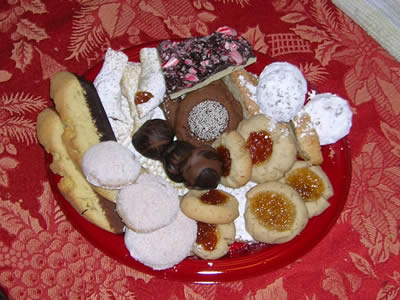
And I am going to have to work twice as hard at the Gym... I've been eating an awful lot of them...
Gino Delivers
We had to cut the cookie baking a bit short because of weather, but what we lacked in quantity, we definitely made up for in quality. Damn, these are some mighty fine cookies!
Victor made Aunt Emma's filling, but Gino made the dough and rolled them out and put 'em together. They may flat-out be the best ever. light, flaky... perfect in every way! Victor and Gino did the bulk of the work - I was at work. But it's pretty obvious they didn't need me around. The stuff they made was just stupendous.
Methinks that next year we'll get Gino down here for a few days and just let him do 'em all. I think he's ready!

